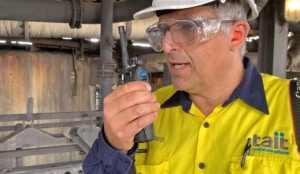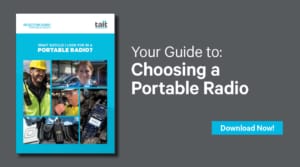Contemporary portable radios are packed with features and options, so it can be hard to know which ones you need. It’s safe to say there’s one feature that is universally important: loud and clear audio. To make sure your voice communications can be heard, it’s crucial to select a portable radio with excellent audio quality.
This blog is part of a series focusing on what factors you should consider when selecting a portable radio – you can find the other posts here.
There are few things more frustrating than not being able to communicate when you need to. Repeating yourself multiple times because of poor audio quality slows things down, and can be life threatening in emergency situations.
Clear audio enables you to hear comms first-time, improving worker safety and keeping voice channels clear. In this blog we will look at some of the key factors that influence the audio quality of a portable radio.
Audio Enhancement Options

Audio Enhancement Options – Click to expand
Something as simple as fine-tuning the settings of the microphone sensitivity or adding the right audio accessory can make a big difference in the audio quality of a portable radio.
To make sure your audio quality is top-notch and suited to your environment, find out whether a radio has any programmable options to tailor the audio for best performance, and check if there are accessories available to improve your audio experience.
Digital Noise Suppression & Active Noise Cancellation
Digital radios use a vocoder to digitize the human voice, enabling it to reduce many types of background noise, and additional Digital Noise Suppression software can be applied to enhance clear speech and minimize background noise even further.
But if you work in high-noise environments, software-based noise suppression might not be enough – you’ll need specialized functionality. Active Noise Cancellation (ANC) receives voice and background noise with two separate microphones, isolating background noise and significantly reducing it, so your voice comms cut through, no matter the noise.
However, ANC technology varies, so it’s important to consider whether a radio’s ANC feature works in analog, digital, or both, and whether it will still work when accessories are connected to your radio.
Speaker Performance
Not all radios are built equally, and as features vary, so do the speakers in portable radios. There are differences in speaker size, wattage and output, all of which influence the loudness and clarity of a radio.
But specs don’t tell the whole story, and there’s no substitute for actually hearing for yourself. When looking for a portable radio, make sure you try them out to hear the difference between individual radios so you can find out what works best for you.
Tait Portable Radio Audio Quality
At Tait, we pride ourselves on the audio quality of our portable radios. All Tait radios are built to exceed international standards with excellent sensitivity, range, and crystal-clear voice functionality, and have a range of programmable functions such as microphone sensitivity level, audio balance, and equalization, that can all be tailored to the operating environment.
And if you are in the need of a radio that’ll cut through even the noisiest environments, The Tait TP9500 and TP9600 radios digital vocoder and Active Noise Cancellation features will ensure your voice will be heard loud and clear through the powerful 3W speaker.
Download our Free Guide to Learn More
If you want to find out more about audio quality and other important factors to consider when choosing a portable radio, download our free Portable Radio Selection Guide.






